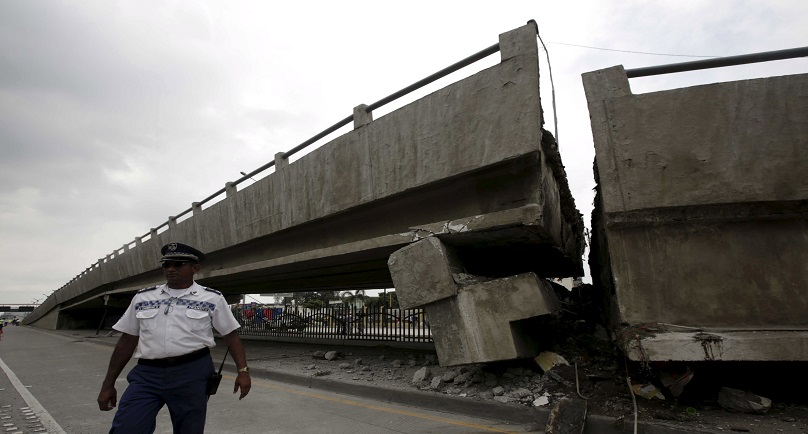Image: An officer walks beside a collapsed bridge after an earthquake struck off the Pacific coast, in Guayaquil, Ecuador, April 17, 2016. REUTERS/Henry Romero
By Julia Symmes Cobb and Daniel Tapia
PEDERNALES, Ecuador (Reuters) – The death toll from Ecuador’s biggest earthquake in decades soared to 272 on Sunday as survivors cobbled together makeshift coffins to bury loved ones, lined up for water and sought shelter beside the rubble of their shattered homes.
The 7.8 magnitude quake struck off the Pacific coast on Saturday and was felt around the Andean nation of 16 million people, causing panic as far away as the highland capital Quito and destroying buildings, bridges and roads.
“Ecuador has been hit tremendously hard… This is the greatest tragedy in the last 67 years,” said a shaken President Rafael Correa, who rushed back to Ecuador from a visit to Italy.
“There are signs of life in much of the rubble and that is the priority,” Correa said in a televised address to the nation.
He confirmed 272 deaths and 2,068 injured and said he feared those figures would increase.
Coastal areas nearest the epicenter were hit hardest, especially Pedernales, a rustic tourist spot with beaches and palm trees now laden with debris from its pastel-colored houses.
Dazed residents recounted a violent shake, followed by a sudden collapse of buildings that trapped people in wreckage.
“You could hear people screaming from the rubble,” Agustin Robles said as he waited in a line of 40 people for water outside a stadium in Pedernales. “There was a pharmacy where people were stuck and we couldn’t do anything.”
Authorities said there were more than 160 aftershocks, mainly in the Pedernales area. A state of emergency was declared in six provinces.
The quake has piled pain on the economy of OPEC’s smallest member, already reeling from low oil prices, with economic growth this year projected at near-zero.
RUBBLE, RAIN, PRISON BREAK
As darkness set in and rain began to fall, survivors bundled up to spend the night next to their destroyed homes. Many had earlier queued up for food, water and blankets outside the blue-and-white stadium.
Inside the stadium, tents housed the dead and medical teams treated hundreds of survivors. About 91 people died in Pedernales and some 60 percent of houses were destroyed, according to Police Chief General Milton Zarate.
“We heard the warning so luckily we were in the street because the entire house collapsed. We don’t have anything,” said Ana Farias, 23, the mother of 16-month-old twins, as she collected water, food and blankets from rescuers.
“We’re going to have to sleep outside today.”
Other survivors hammered together shelters in empty lots. Police patrolled the dark town, where power remained off, while some rescuers plowed on.
Locals used a small tractor to remove rubble and also searched with their hands for trapped people. Women cried after a corpse was pulled out.
In Portoviejo, around 180 kilometers (112 miles) south of Pedernales, authorities said some 130 inmates escaped from the El Rodeo prison after its walls collapsed. More than 35 have been recaptured.
In Ecuador’s largest city, Guayaquil, rubble lay in the streets and a bridge fell on top of a car
“It was horrible. It was as if it was going to collapse like cardboard,” said Galo Valle, 56, who was guarding a building in the city where windows fell out and parts of walls broke.
“I prayed and fell to my feet to ask God to protect me.”
About 13,500 security force personnel were mobilized to keep order around Ecuador, and $600 million in credit from multilateral lenders was immediately activated for the emergency, the government said.
REFINERY SHUT, GALAPAGOS UNSCATHED
It has been decades since the government dealt with an earthquake of this magnitude. In a 1979 disaster, 600 people were killed and 20,000 injured, according to the U.S. Geological Survey.
According to the country’s Geophysics Institute, 230 aftershocks have been registered after the subduction, an event in which one tectonic plate goes under another.(http:https://goo.gl/smIFMb)
Venezuela, Chile and Mexico were sending personnel and supplies, the left-leaning Correa government said. The Ecuadorean Red Cross mobilized more than 800 volunteers and staff and medical charity Medecins Sans Frontieres said it was sending a team from Colombia.
Canadian Prime Minister Justin Trudeau said on Twitter that two Canadians were among the dead and that the “scope of the devastation in Ecuador is shocking.” [L2N17L008]
The U.S. State Department said in an email that it was working to confirm reports of Americans injured in the quake, although it had no reports of any U.S. citizens killed.
U.S. Secretary of State John Kerry offered assistance.
Although tsunami warnings were lifted, coastal residents were still urged to seek higher ground in case tides rise.
The government said oil production was not affected but closed its main refinery of Esmeraldas, located near the epicenter, as a precaution. It was likely to restart soon.
Residents on the Galapagos islands far off Ecuador’s coast, home to numerous rare species, said they had not been affected by the quake.
The Ecuadorean quake followed two large and deadly quakes that’struck Japan since Thursday. Both countries are located on the seismically active “Ring of Fire” that circles the Pacific, but according to the U.S. Geological Survey large quakes separated by such distances would probably not be related.
(Additional reporting by Alexandra Valencia and Cristina Munoz in Quito, Javier Andres Rojas in Pedernales, Yuri Garcia in Guayaquil, Guillermo Granja in Manta, Girish Gupta in Bogota; Writing by Andrew Cawthorne and Alexandra Ulmer; Editing by Bill Trott and Mary Milliken)
Copyright 2015 Thomson Reuters. Click for Restrictions.


